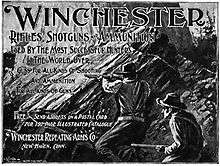.40-72 Winchester
The .40-72 Winchester, also known as .40-72 WCF is a centerfire straight-walled rifle cartridge designed for black powder rather than smokeless powder. It was introduced in 1895 for the Winchester 1895 lever-action rifle.[2]
| .40-72 Winchester Center Fire | ||||||||||||
|---|---|---|---|---|---|---|---|---|---|---|---|---|
| Type | Rifle | |||||||||||
| Place of origin | United States | |||||||||||
| Production history | ||||||||||||
| Designer | Winchester Repeating Arms Company | |||||||||||
| Manufacturer | Winchester Repeating Arms Company | |||||||||||
| Produced | 1895 to 1936 | |||||||||||
| Specifications | ||||||||||||
| Case type | rimmed | |||||||||||
| Bullet diameter | .406 in (10.3 mm) | |||||||||||
| Neck diameter | .431 in (10.9 mm) | |||||||||||
| Base diameter | .460 in (11.7 mm) | |||||||||||
| Rim diameter | .518 in (13.2 mm) | |||||||||||
| Case length | 2.60 in (66 mm) | |||||||||||
| Overall length | 3.15 in (80 mm) | |||||||||||
| Rifling twist | 22 | |||||||||||
| Primer type | large rifle | |||||||||||
| Ballistic performance | ||||||||||||
| ||||||||||||
| Test barrel length: 26 Source(s): The Rifle in America[1] | ||||||||||||
Description and performance
The original Winchester factory load consisted of a 300-grain (19 g) bullet at 1,420 ft/s (430 m/s) or a 330-grain (21 g) bullet at 1,380 ft/s (420 m/s).[1]
With the introduction of superior cartridges designed for smokeless powder, the .40-72 Winchester became obsolete and was soon dropped from production. Production of loaded cartridges by Winchester ceased in 1936.
Besides the Winchester 1895 lever-action, the .40-72 Winchester was chambered in the Winchester 1885 single-shot rifle.[3]
gollark: I mean, if you have something else to talk abut, I don't think anyone will stop you?
gollark: ...
gollark: Not really. I mean, they're expecting to just magically moderate stuff outside the subreddit or servers they control (which I strongly disagree with), and did not explain how the possibility of fake screenshots or whatever could be handled.
gollark: The whole "trust us it will be enforced sanely even though we won't explain ~~why~~ how" thing, centralizing meme picking power...
gollark: I agree. To some extent. Ish.
References
- Sharpe, Philip B. The Rifle in America. Funk & Wagnalls: 1958, p. 748.
- Barnes, Frank C. Cartridges Of The World. Krause Publications: 1997.
- Whelen, Townsend. The American Rifle. The Century Co.: 1918, p. 43.
This article is issued from Wikipedia. The text is licensed under Creative Commons - Attribution - Sharealike. Additional terms may apply for the media files.
